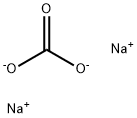A8550432
Potassium carbonate solution , 1mol/L , 584-08-7
Synonym(s):
Dipotassium carbonate;potash;Potassium carbonate
CAS NO.:584-08-7
Empirical Formula: K2CO3
Molecular Weight: 138.21
MDL number: MFCD00011382
EINECS: 209-529-3
| Pack Size | Price | Stock | Quantity |
| 100ML | RMB31.20 | In Stock |
|
| 500ML | RMB79.20 | In Stock |
|
| others | Enquire |
Update time: 2022-07-08
PRODUCT Properties
| Melting point: | 891 °C (lit.) |
| Boiling point: | decomposes [STR93] |
| Density | 2.43 g/mL at 25 °C |
| bulk density | 750kg/m3 |
| storage temp. | Store at +5°C to +30°C. |
| solubility | H2O: 1 M at 20 °C, clear, colorless |
| pka | 10.33[at 20 ℃] |
| form | powder |
| color | Yellow |
| Specific Gravity | 2.29 |
| PH | 10.52(1 mM solution);11(10 mM solution);11.36(100 mM solution); |
| Odor | at 100.00?%. odorless |
| Water Solubility | 1120 g/L (20 ºC) |
| Sensitive | Hygroscopic |
| λmax | λ: 260 nm Amax: 0.03 λ: 280 nm Amax: 0.02 |
| Merck | 14,7619 |
| BRN | 4267587 |
| Dielectric constant | 5.6(16.0℃) |
| Stability: | Stable. Incompatible with moisture, acids, magnesium bromine trifluoride and magnesium bromine trichloride. |
| CAS DataBase Reference | 584-08-7(CAS DataBase Reference) |
| NIST Chemistry Reference | Dipotassium carbonate(584-08-7) |
| EPA Substance Registry System | Potassium carbonate (584-08-7) |
Description and Uses
Potassium carbonate is used in the chemical industry as a source of inorganic potassium salts (potassium silicates, potassium bicarbonate), which are used in fertilizers, soaps, adhesives, dehydrating agents, dyes, and pharmaceuticals. Potassium carbonate used to make potassium lye produces soft soaps, which are liquids or semisolids rather than solids. Other uses of potassium carbonate includes use as a fire suppressant in extinguishers, as a CO2 absorbent for chemical processes and pollution control, an antioxidant in rubber additives, and in pharmaceutical formulations.
Safety
| Symbol(GHS) |  GHS07 |
| Signal word | Warning |
| Hazard statements | H315-H319-H335 |
| Precautionary statements | P261-P264-P271-P280-P302+P352-P305+P351+P338 |
| Hazard Codes | Xn |
| Risk Statements | 22-36/37/38-20/21/22 |
| Safety Statements | 26-36-37/39 |
| RIDADR | 3262 |
| WGK Germany | 1 |
| RTECS | TS7750000 |
| F | 3 |
| TSCA | Yes |
| PackingGroup | III |
| HS Code | 28364000 |
| Hazardous Substances Data | 584-08-7(Hazardous Substances Data) |
| Toxicity | LD50 orally in rats: 1.87 g/kg, H. F. Smyth et al., Am. Ind. Hyg. Assoc. J. 30, 470 (1969) |


